
views
X
Trustworthy Source
PubMed Central
Journal archive from the U.S. National Institutes of Health
Go to source
Research suggests you may not have any symptoms with a hookworm infection, but common symptoms include abdominal discomfort, diarrhea, nausea, vomiting, gas, cough, fatigue, fever, itchy rash, and pale skin.[2]
X
Trustworthy Source
MedlinePlus
Collection of medical information sourced from the US National Library of Medicine
Go to source
Try not to worry if you think you might have a hookworm infection because treatments are available.
Diagnosing Hookworm

Consider your exposure to high-risk areas. Hookworm is most common in developing nations in Asia, sub-Saharan Africa, and Latin America. Areas with poor sanitation, water treatment, and plumbing/sewage infrastructure are especially at risk. The hookworm larvae live in the soil and migrate toward the surface in search of oxygen and sunlight. Coming into contact with soil in high-risk areas — whether by hand or by walking barefoot — increases your odds of infection. Sunbathing on your back can also cause infection. Hookworms thrive best in a moist, sandy environment.
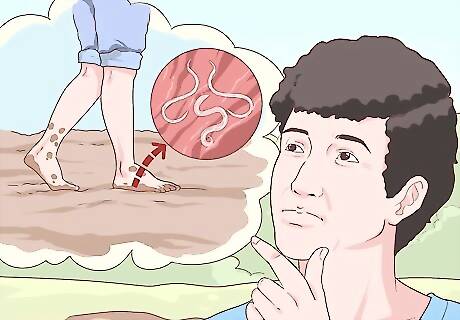
Think about how you could have contracted hookworm. There are three ways to contract hookworm: through skin penetration, oral ingestion, and rarely via breast milk. If you either live in or have visited a high-risk area, think about whether any of those modes of transmission are possible. Skin penetration is most common through the feet, but can occur anywhere on the body. You can contract it orally by eating food prepared by an infected host or coming into contact with infected feces. Dog and cat owners, especially, can contract hookworm while handling their pets' feces. Soil can become contaminated by pet feces, as well. Consider whether you've walked barefoot somewhere dogs or cats defecate.
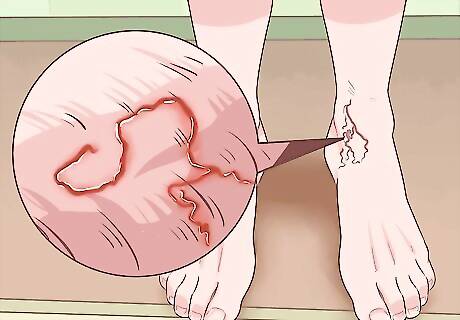
Watch for a "serpiginous rash." If you have an infection type called "cutaneous larva migrans," you may develop a very memorable rash. The word "serpiginous" shares a root with "serpent," or snake. The rash has that name because you can see the hookworms moving around under the surface of the skin, like snakes. This rash migrates one to two centimeters a day, from which we get the "migrans" part of the name.
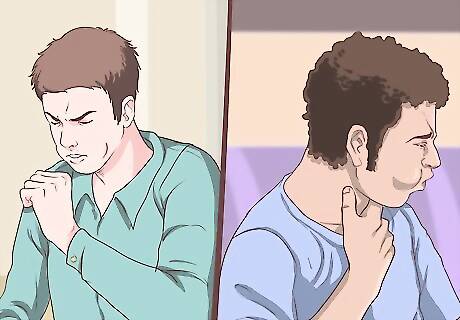
Look for mild coughing or sore throat. Once you've contracted hookworm, they find their way into your bloodstream. When they reach the lungs, they penetrate the air sacs around the lung (alveoli) and cause inflammation. This may result in a mild cough or perhaps a sore throat while the larvae continue up the airway toward the glottis. Other symptoms of this stage might include: Wheezing Headache Coughing up blood

Notice signs of anemia. As the larvae approach the glottis, they get swallowed and make their way to the small intestine. They attach to the intestinal walls with their teeth, causing blood loss as they feed on protein. If they are allowed to mature in the intestines, they can cause malnutrition and anemia. Symptoms of anemia include: Fatigue Weakness Pale skin A fast or irregular heartbeat Shortness of breath Chest pain Dizziness Cognitive problems Cold hands and feet Headache
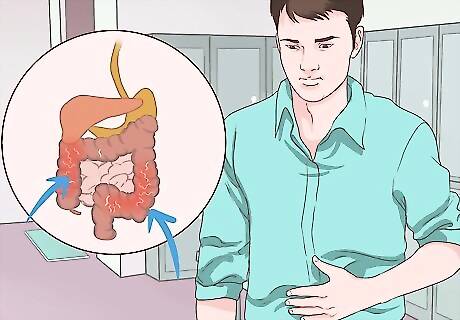
Do not ignore stomach pain. Hookworms migrate to the intestines, so gastrointestinal discomfort is not uncommon, especially following eating. Because the hookworms repeatedly bite the intestinal wall, the pain is like an internal bee sting. Other gastrointestinal problems may include diarrhea, appetite loss, or weight loss.

Note that many patients do not exhibit symptoms. The severity of symptoms depends on the "load" or "worm burden." If you have 100-500 larvae in your system, symptoms will be mild or nonexistent. A medium load is 500 or larger, and a large load is 1,000 or greater.

Seek early diagnosis. If you live in a high-risk area, ask the doctor to make hookworm testing part of your regular checkup. If you recently travelled to a high-risk area, see your doctor when you return. Give her a thorough history of your travels, as well as your interactions with dogs and cats. The doctor may perform the following tests to diagnose a hookworm infection: Analysis of a stool sample for eggs and parasites A chest radiograph to look for larvae in the lungs A complete blood count (CBC) and iron panel to check for anemia
Treating Hookworm
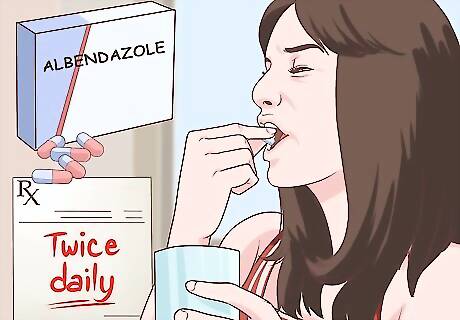
Follow the anthelmintic drug schedule your doctor prescribes. Anthelmintic drugs attack intestinal parasites like hookworms. Different species of hookworm cause different types of infections. Though there is a small degree variation for specific diagnoses, in general, treatment is the same for all types: Take 100 mg of Mebendazole three times daily. The dosing for this drug is the same for both adults and children. Take one 400 mg dose of Albendazole for most hookworm cases. If, after two weeks, the lab still finds eggs in your stool sample, you will take a second dose. If you have an infection called "visceral larva migrans," take 400 mg of Albendazole twice daily for five to twenty days. Take 325 mg of ferrous sulfate three times daily for six weeks to treat iron deficiency. Take 1000 mg of Vitamin C supplement daily for six weeks. Take anti-itch medication like benadryl, atarax, or hydrocortisone cream for cutaneous larva migrans.
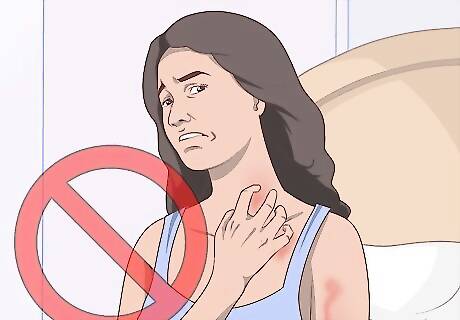
Refrain from scratching itchy rashes under any circumstance. The itching is caused by worms just under the surface of your skin. Scratching might get worms lodged under your fingernails. You might ingest them with food or introduce them to the rectum when using the restroom. Scratching also raises your chances of getting a bacterial skin infection. It's important to avoid scratching a hookworm rash at all costs. Covering the rash with long sleeves or pants might prevent you from absent-minded scratching.
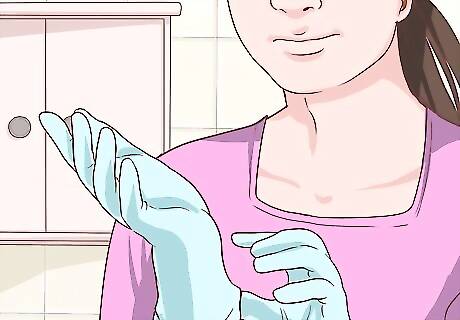
Protect your hands from fecal matter. When using the restroom, keep your hands away from your rectum. If larvae in your stool get on your hands or touch your skin, the process begins all over again. To be safe, consider wearing disposable latex gloves until the tests show you are free of hookworms.

Complete iron therapy if necessary. Because hookworms cause blood loss, an infection often results in iron-deficient anemia. If you have this condition, the doctor will recommend a course of iron supplements and dietary change to normalize your levels. Very rarely, severe anemia may call for blood transfusions, iron injections, or IV iron therapy. The best food sources of iron are meat products, especially red meat. Other iron sources include: Iron-fortified breads and cereals Peas; lentils; white, red, and baked beans; soybeans; and chickpeas Tofu Dried fruits, such as prunes, raisins, and apricots Dark leafy greens Prune juice
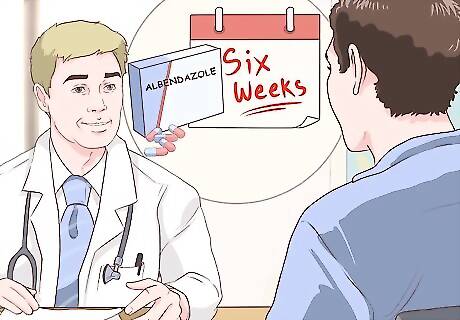
Revisit the doctor as directed. The appointment schedule may vary depending on the doctor's evaluation of your particular case. In general, though, you may be asked to return for a stool sample analysis after two weeks. If, at that time, the lab still finds hookworm eggs in your stool, the doctor will prescribe another dose of Albendazole. Six weeks after the initial treatment, the doctor will order another complete blood count. If your lab values don't fall within healthy levels, you will repeat the therapy for another six weeks, then repeat the CBC.
Preventing Reinfection During and After Treatment
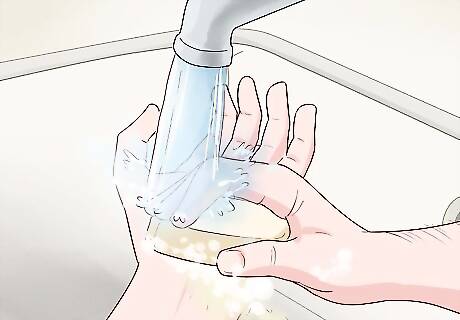
Wash your hands thoroughly. Wash your hands after coming into contact with potentially contaminated soil or feces, and always before you eat. Make sure you are cleaning under your nails, between your fingers, and above your wrist. Use warm or hot water and soap, scrubbing for at least 20 seconds. If you're not sure how long to scrub, simply sing the "Happy Birthday" song twice in a row.

Always wear shoes outdoors. This is especially important if you are in a high-risk location. However, walking barefoot anywhere can put your skin in contact with larvae from dog or cat feces. Even flip flops or open-toed shoes can potentially expose your skin to infection.
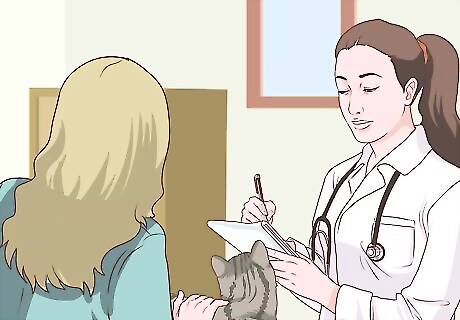
Have the veterinarian check and deworm cats and dogs annually. Even if your pet was dewormed when you adopted it from the shelter, it can come into contact with hookworms at a later time. During its annual checkup, provide the veterinarian with a stool sample to be checked for worms. If he or she confirms that your pet has worms, get it dewormed immediately.
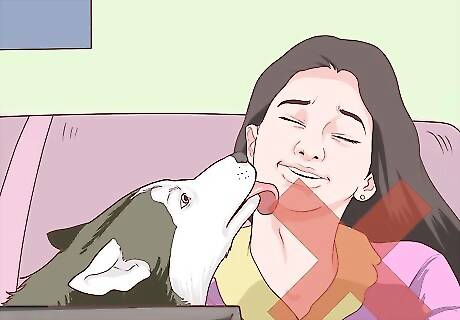
Never let your pet lick you on the mouth. Dogs especially love to show their love by licking their human on the face, including the mouth. If the pet has recently eaten, sniffed, or otherwise investigated infected stool, the A Caninum species may be transferred to your skin.
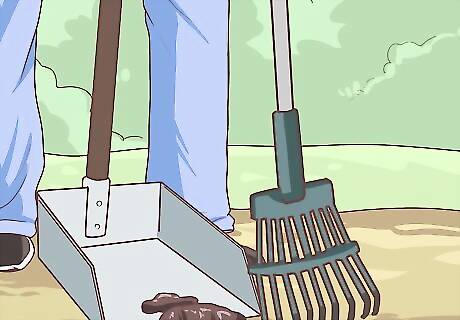
Take care when handling pet feces. Even if you think you’re being safe when picking up your dog’s feces or cleaning your cat’s litter box, it’s better safe than sorry. Use a special pooper scooper when picking up feces, rather than placing your hands anywhere in the vicinity of potentially infected stool. If you can afford it, you might consider hiring a pet waste removal service.
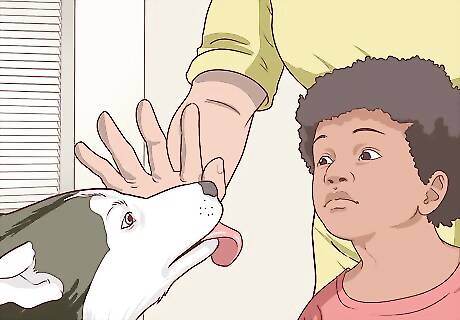
Monitor children closely. Even for adults, containing a hookworm infection can be hard. You have a rash you can’t itch, a pet whose mouth you have to avoid, and the constant threat of reinfection through your own stool. Children, then, need extra help to prevent spreading the infection to others or reinfecting themselves. Watch them especially when they’re around pets to make sure they stay away from their mouths. Don’t allow them to play in potentially infected soil, and especially make sure they don’t eat any dirt.

Make sure your water and food are clean and sterile. Water for drinking, bathing, and cooking should be sterile. If you're not certain of the purity of the water, make sure you boil it and then allow it to cool down before use. Make sure your food is fully cooked.













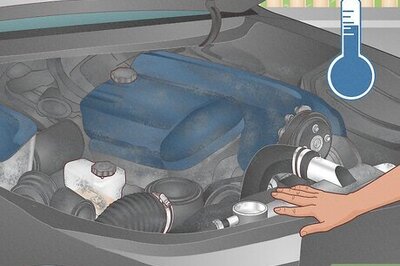




Comments
0 comment